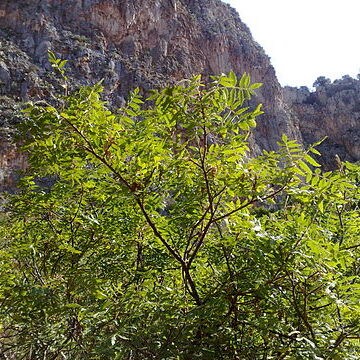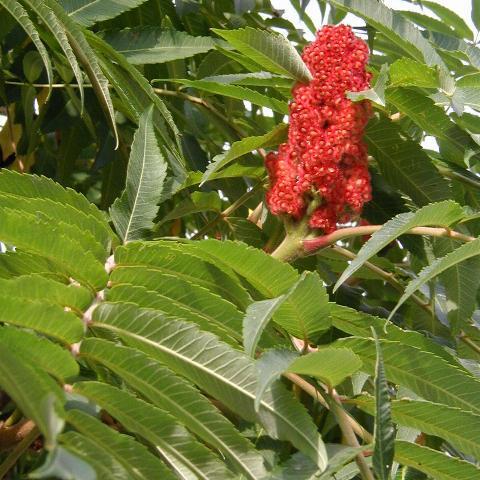Suffrutices, shrubs or trees. Leaves alternate, simple, 3-foliolate or imparipinnate, rarely digitately 5-foliolate. Inflorescences of terminal and/or axillary panicles. Flowers unisexual, occasionally bisexual, very small. Male flowers: calyx (4–)5(–6)-partite, segments imbricate; petals (4–)5(–6), longer than the calyx, imbricate; stamens 5, filaments subulate, inserted below the disk, anthers ovate, dorsifixed, introrse; disk saucer-or cup-shaped; pistillode usually absent. Female flowers: perianth similar to ♂; staminodes frequently present; ovary ovoid to subglobose, usually unilocular, with the ovule pendent from an ascendent funicle inserted at the base of the locule; styles 3, apical, free or occasionally connate at the base; stigmas somewhat capitate. Drupe globose or ovoid and compressed, frequently asymmetrical, glabrous or hairy; mesocarp fleshy, somewhat resinous, sometimes rather dry; endocarp bony or crustaceous. Seed ovoid or reniform, compressed, with a thin testa; cotyledons very compressed.
Trees or (not in Australia) shrubs, sometimes lianes. Leaves alternate, compound or (not in Australia) simple. Inflorescence terminal and axillary. Flowers unisexual or (not in Australia) bisexual. Calyx lobes 5. Petals mostly 5, imbricate. Disc present. Male flowers: stamens 5; anthers dorsifixed, introrse to latrorse; pistillode present. Female flowers: staminodes present; ovary 1-locular with 1 ovule attached to wall near base by a long funicle; style sometimes obscure; stigmas 3, free or united. Fruit a drupe, 1-locular, 1-seeded; exocarp membranous; mesocarp ±resinous; endocarp coriaceous, crustaceous or bony. Seed with testa adhering to or free from endocarp. Embryo straight; cotyledons free, flat.
Trees or shrubs, sometimes climbing, usually dioecious, usually deciduous, sometimes evergreen but not in N.Z. Sap resinous or milky. Lvs usually imparipinnate, sometimes 3-foliolate or simple. Panicles terminal or axillary, bracteate. Calyx 5-partite; segments imbricate, sometimes unequal. Petals 5, ± imbricate, inconspicuous. ♂ fls with 5 stamens and rudimentary pistil. ♀ fls 1-celled; styles 3; stigmas ± capitate. Drupe globose or compressed; exocarp thin, glabrous or hairy; mesocarp resinous; endocarp ± bony; stigmas often persistent.
Deciduous shrubs or trees, polygamous or dioecious. Leaves imparipinnately compound; leaf rachis sometimes winged; leaflets petiolate or sessile, with serrate or entire margin. Inflorescence terminal, paniculate or thyrsoid, floral subtending bracts persistent or deciduous. Flowers functionally unisexual or bisexual, 5-merous. Ovary 1-locular and 1-ovulate; styles 3, often united basally. Drupe globose, slightly compressed, mixed glandular pubescent and pilose, red at maturity; exocarp and mesocarp united; mesocarp glutinous, red.
Pet 5, often hairy, especially on the inner surface; stamens 5; ovary 3-carpellate but unilocular, with a short, terminal, 3-lobed style; ovule basal; frs red or reddish, glandular-hairy; innocuous, polygamo-dioecious shrubs or small trees with dense, crowded infls terminal or lateral on last-year’s twigs. (Schmaltzia) 100, cosmop.
Female flowers: perianth similar to that of the male; staminodes frequently present; ovary ovoid to subglobose, usually 1-locular, with the ovule pendent from an ascendent funicle inserted at the base of the loculus; styles 3, apical, free or connate at the base; stigmas ± capitate.
Male flowers: calyx (4)5(6)-partite, the segments imbricate; petals (4)5(6), longer than the calyx, imbricate; stamens 5; filaments subulate, inserted below the disk; anthers ovate, dorsifixed, introrse; disk patellifonn or cupuliform; pistillode usually absent.
Drupe globose or ovoid and compressed, frequently asymmetrical, glabrous or hairy; mesocarp fleshy, ± resinous, sometimes ± dry; endocarp bony or crustaceous.
Leaves alternate, simple, 3-foliolate or imparipinnate, rarely digitately 5-foliolate.
Seed ovoid or reniform, compressed, with a thin testa; cotyledons very compressed.
Flowers unisexual, exceptionally bisexual, very small.
Panicles terminal, axillary or both, ± branched.
Shrublets, suffrutices, shrubs or trees.


